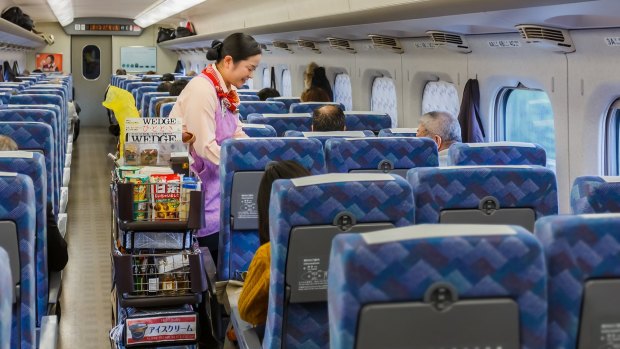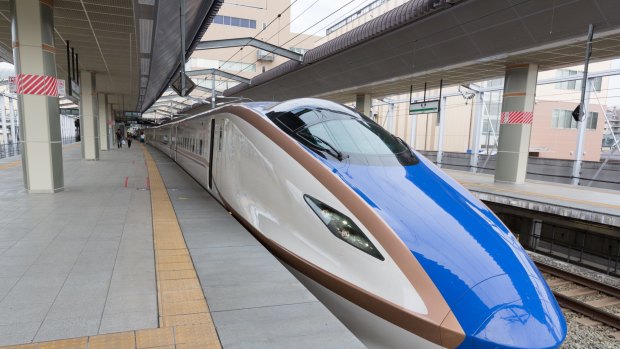Guide to travelling on shinkansen: Why Japan's bullet trains are the world's best way to travel

Japanese trains don't have restaurant or bar cars, only snack trolleys.Credit: iStock
Find me a better way to travel than a Japanese train. Seriously, hunt around, prod and poke every corner of the travelling world, and see if you can come up with a better way to get from A to B than a train in the Land of the Rising Sun.
I will be very surprised if you can persuade me of one.
Japanese trains are the ultimate. They're fast, they're efficient, they're clean, they're safe, they're comfortable, they're used widely by the local population, they go everywhere, they're connected by a huge series of amazing station facilities, and there are so many of them that you pretty much never need to wait more than a few minutes for one, regardless of whether you're travelling five minutes on the Tokyo subway or five hours on the shinkansen.

Japanese trains are the greatest. Still, for first-timers they can be a little intimidating.Credit: iStock
Japanese trains are the greatest. Still, for first-timers they can be a little intimidating. There's a hefty language barrier to negotiate here, not to mention the physical difficulty of navigating, say, Shinjuku Station, which has 53 platforms accessible via more than 200 entrances, utilised by more than 3.5 million people every day.
How do you buy tickets for Japanese trains? How much do you pay for them? How do you best utilise them?
Once you know what you're doing, this is all very easy. And so, this story aims to ensure you know what you're doing.
To begin with, you need to know the different types of trains and companies in Japan. In larger cities you will generally have an underground metro network, which could be serviced by just the one company, or in the case of Tokyo, several. You then have an above-ground network of intra-city trains, usually serviced by Japan Rail.
Then there are inter-city trains, which again are usually provided by JR or its subsidiaries; these trains range from modest rural rattlers (some even cable cars or cog railways or funiculars), to all-stations commuter trains, to the shinkansen, or bullet trains.
As soon as you arrive in Japan, buy an IC card. These are prepaid, rechargeable travel cards that will get you on board almost all trains, subways and buses across Japan's major cities (you can also use them to buy things at vending machines, shops and restaurants, and even pay cab fares with them).
There are 10 major IC cards in Japan, and it really doesn't matter which one you buy – they all work everywhere. If you arrive in Tokyo it will be Suica or Pasmo card; if you fly into Osaka it will be Icoca or Pitapa. It doesn't matter. Pick one up from the ticket machines at any major railway station.
(Tourists can also apply for various special versions of these cards – Welcome Suica, Pasmo Passport and Kansai One Pass – which don't require a deposit fee, but expire after four weeks and don't allow refunds.)
Now that you have access to all those trains, you need to figure out which ones to catch, and here Google Maps is your best friend. Open up the app, plug in the place you need to go, and the app will tell you not just which trains to catch, but which entrance and exit to use at the stations, which platform to go to, and even where to stand on the platform for the easiest transfer. Oh, and also how much the journey will cost.
That works for every form of public transport across the country. It's a total game-changer and you need to ensure you have internet access to utilise it.
You've probably heard, by now, about the JR Pass, a ticket only available to foreign tourists, which will get you access to unlimited long-distance trains, including shinkansen (plus various intra-city transport), for a set period of time.
These are great value if you're planning to move around the country a lot; if you're only visiting one or two cities, they don't really make sense. So think about where you're planning to go, and do the sums.
You will need to buy your JR Pass online from a registered retailer before you leave Australia (this is seriously old-school: an "exchange order" will be posted to your house, and you will then exchange that for your JR Pass at a train station once you get to Japan). For a seven-day adult pass you're looking at about $330, which isn't great for just one or two long-distance journeys, but excellent value if you'll be moving around more.
When travelling with your JR Pass, you can choose to reserve a seat on your train of choice (which can be done at major train stations), or just turn up and hope to grab a spot in the unreserved section of the train. Unless you're travelling during holidays or at peak commuting times, there will usually be a seat.
And if you will be travelling by shinkansen, know this: they leave on time. Almost always. Bang on time. So make sure you're on the platform, at the right spot (signs on the ground and on the barriers will point you to where your car will pull up), and ready to go a few minutes beforehand.
Be sure to grab some food for the journey, too. Japanese trains don't have restaurant or bar cars, only snack trolleys, and travellers tend to buy their meals at the train station before they depart. Fear not, of course: these bento-box meals are fresh and delicious, and reasonably priced.
Once you're on board, sit back in your comfy seat, crack open a beer, dig into your bento, and watch the world go by at more than 300 kilometres per hour. There's nothing better.
Email: b.groundwater@traveller.com.au
Instagram: instagram.com/bengroundwater
Twitter: twitter.com/bengroundwater
Sign up for the Traveller Deals newsletter
Get exclusive travel deals delivered straight to your inbox. Sign up now.